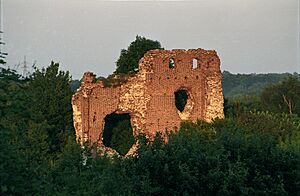Bochotnica facts for kids
Quick facts for kids
Bochotnica
|
|
|---|---|
|
Village
|
|

Castle ruins in Bochotnica
|
|
| Country | |
| Voivodeship | Lublin |
| County | Puławy |
| Gmina | Kazimierz Dolny |
| Population | 1,000 |
Bochotnica is a village in eastern Poland. It is part of the Lublin Voivodeship, in the Puławy County. The village is located near the Vistula River. It lies about 3 kilometers northeast of Kazimierz Dolny. It is also about 10 kilometers south of Puławy. Bochotnica is known for the ruins of a castle built in the 1300s.
Contents
Discovering Bochotnica's Past
Bochotnica is one of the oldest settlements in the Lesser Poland region. In the past, it was sometimes called Bochotnica Mała. This helped tell it apart from nearby Bochotnica Wielka. Long ago, when Poland was a kingdom, Bochotnica was an important defensive settlement. It was located on a trade route that connected Kievan Rus with central Poland.
Early History and Discoveries
Even though old papers don't fully prove it, archaeologists believe Bochotnica was a defensive place as early as the 500s. In 1993, they found exciting things here. They discovered remains of an old fort, called a gord. They also found an ancient burial ground. Many interesting items were uncovered, like bronze and iron tools. They even found gold coins and a sword from the 900s!
Bochotnica, along with a nearby place called Wąwolnica, was once an important local center. In 1317, King Władysław Łokietek gave Bochotnica and other villages to two brothers.
The Castle of Bochotnica
The defensive castle in Bochotnica was likely built around 1340. This was after a big attack by the Tatars on the Lublin area. The castle was shaped like a rectangle. It was built on a hill, which gave it a great view of the surrounding land.
In the 1400s, the Kurowski family owned the castle. Later, it belonged to Jan Oleśnicki, who was a leader in Lublin. He even changed his last name to Bochotnicki. He made changes to the castle, updating it in the Renaissance style. Jan Bochotnicki did not have children. After he passed away in the late 1500s, the castle slowly became a ruin.
Over the years, many different families owned the village of Bochotnica. These included the Borkowski, Tarło, Lubomirski, Sanguszko, and Potocki families. In 1826, Adam Jerzy Czartoryski owned it. However, his properties were taken by the Russians after a rebellion. In 1886, a new owner thought about rebuilding the castle, but he changed his mind.
Bochotnica Through the Centuries
Until the time of the Partitions of Poland, Bochotnica was part of the Lublin Voivodeship. In 1815, it became part of Congress Poland, which was controlled by Russia. After World War I, Bochotnica became part of Poland again.
World War II and Beyond
During World War II, on November 18, 1942, a tragic event occurred in the village square. Many people lost their lives there. After the war, Bochotnica was a place where people resisted the new communist government. On May 24, 1945, a conflict took place between a former Home Army unit and Soviet agents.
Bochotnica Today
Today, Bochotnica is a local tourist spot. People visit because of the beautiful Lesser Polish Gorge of the Vistula and the nearby Kazimierz Landscape Park. The village does not have a train station. The closest one is in Puławy. Bochotnica is also a place where three roads meet, making it easy to reach by car.
See also
 In Spanish: Bochotnica para niños
In Spanish: Bochotnica para niños


